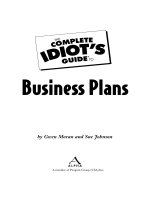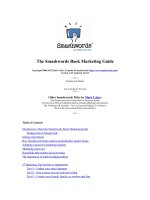The product managers field guide
Bạn đang xem bản rút gọn của tài liệu. Xem và tải ngay bản đầy đủ của tài liệu tại đây (3.27 MB, 239 trang )
This page intentionally left blank.
Practical Tools, Exercises,
and Resources for Improved
Product Management
THE
Product
Manager’s
Field Guide
▼
Linda Gorchels
00 (i-x) front matter 3/27/03 15:45 Page iii
Copyright © 2003 by Linda Gorchels. All rights reserved. Manufactured in the United States of America. Except
as permitted under the United States Copyright Act of 1976, no part of this publication may be reproduced or dis-
tributed in any form or by any means, or stored in a database or retrieval system, without the prior written permis-
sion of the publisher.
0-07-142623-X
The material in this eBook also appears in the print version of this title: 0-07-141059-7
All trademarks are trademarks of their respective owners. Rather than put a trademark symbol after every occur-
rence of a trademarked name, we use names in an editorial fashion only, and to the benefit of the trademark
owner, with no intention of infringement of the trademark. Where such designations appear in this book, they
have been printed with initial caps.
McGraw-Hill eBooks are available at special quantity discounts to use as premiums and sales promotions, or for
use in corporate training programs. For more information, please contact George Hoare, Special Sales, at
or (212) 904-4069.
TERMS OF USE
This is a copyrighted work and The McGraw-Hill Companies, Inc. (“McGraw-Hill”) and its licensors reserve all
rights in and to the work. Use of this work is subject to these terms. Except as permitted under the Copyright Act
of 1976 and the right to store and retrieve one copy of the work, you may not decompile, disassemble, reverse
engineer, reproduce, modify, create derivative works based upon, transmit, distribute, disseminate, sell, publish
or sublicense the work or any part of it without McGraw-Hill’s prior consent. You may use the work for your
own noncommercial and personal use; any other use of the work is strictly prohibited. Your right to use the work
may be terminated if you fail to comply with these terms.
THE WORK IS PROVIDED “AS IS”. McGRAW-HILL AND ITS LICENSORS MAKE NO GUARANTEES
OR WARRANTIES AS TO THE ACCURACY, ADEQUACY OR COMPLETENESS OF OR RESULTS TO BE
OBTAINED FROM USING THE WORK, INCLUDING ANY INFORMATION THAT CAN BE ACCESSED
THROUGH THE WORK VIA HYPERLINK OR OTHERWISE, AND EXPRESSLY DISCLAIM ANY WAR-
RANTY, EXPRESS OR IMPLIED, INCLUDING BUT NOT LIMITED TO IMPLIED WARRANTIES OF
MERCHANTABILITY OR FITNESS FOR A PARTICULAR PURPOSE. McGraw-Hill and its licensors do not
warrant or guarantee that the functions contained in the work will meet your requirements or that its operation
will be uninterrupted or error free. Neither McGraw-Hill nor its licensors shall be liable to you or anyone else for
any inaccuracy, error or omission, regardless of cause, in the work or for any damages resulting therefrom.
McGraw-Hill has no responsibility for the content of any information accessed through the work. Under no cir-
cumstances shall McGraw-Hill and/or its licensors be liable for any indirect, incidental, special, punitive, conse-
quential or similar damages that result from the use of or inability to use the work, even if any of them has been
advised of the possibility of such damages. This limitation of liability shall apply to any claim or cause whatso-
ever whether such claim or cause arises in contract, tort or otherwise.
DOI: 10.1036/007142623X
ebook_copyright 7x9.qxd 7/23/03 11:01 AM Page 1
Want to learn more?
We hope you enjoy this McGraw-Hill eBook! If you d like
and websites, please click her
e.
DOI Page 6x9 11/12/02 10:11 AM Page 1
more information about this book, its author, or related books
,
Contents
CHAPTER 1 Assets of Influential Product Managers 1
Drive Business Results 3
Deliver Results Through People 6
Ensure Market-Driven Direction 11
Guide Product “Fit” and Function 13
Manage Multiple Priorities 16
Entrepreneurial Skills and Traits 17
Creating the Product Manager Scorecard 18
CHAPTER 2 Project and Time Management Foundations 21
Project Management Fundamentals 22
Time Management 28
CHAPTER 3 Planning Framework 35
Clarify Your Scope 35
Environmental Scan 36
Goals and Objectives 40
Strategies and Tactics 41
Implementation 45
Tracking 46
CHAPTER 4 Market Research 53
Create a Source Network 53
Formulate the Research Problem 54
Design and Schedule the Project 64
Prepare Field Procedures 65
Develop Questionnaire 66
v
00 (i-x) front matter 3/27/03 15:45 Page v
For more information about this title, click here.
Copyright 2003 by Linda Gorchels. Click Here for Terms of Use.
Collect, Edit, and Code Data 69
Process Data and Make Decisions 70
CHAPTER 5 Financial Foundations of Planning 75
Evaluating Product Lines 76
Flexible Product Budgets 78
Product Costing 81
Evaluating Investment Alternatives 89
CHAPTER 6 Product and Brand Portfolio Analysis 93
Product Line Planning 94
Brand Equity Management 99
Global Product Planning 101
Product Rationalization 104
CHAPTER 7 Strategic Visioning and Planning 107
Strategic Thinking 107
Strategy Development 111
Strategy Implementation 117
CHAPTER 8 Concept and Development of New Products 121
New Product Objectives 121
Idea Generation 123
Forecasting and Concept Screening 126
Concept Refinement and Specification of Requirements 132
Prototype Testing 137
CHAPTER 9 Launch Guidelines for New Products 143
Launch Preparation: Start Early 143
Implement the Launch: Establish Buy-In and Support 157
Post-Launch Tracking: Early Course Correction 164
vi • Contents
00 (i-x) front matter 3/27/03 15:45 Page vi
CHAPTER 10 Pricing Frameworks and Tactics 171
Pricing Goals and Objectives 171
New Product Pricing 173
Pricing Product Line Extensions 175
Price Decision Factors 177
Pricing Supplementary Services and Options 178
Price Erosion in the Industry 179
Initiating Price Changes 180
Sales Force Discounting 181
Global Pricing 182
CHAPTER 11 Integrated Marketing Communications 187
Marketing Communications 188
Brand Equity and Positioning 189
Integrating the Marketing Communications 193
Sales Support Materials 199
Complementary Communications Efforts 200
CHAPTER 12 “Go to Market” Strategies 205
Strategic Fit Questions 206
Ongoing Support 212
Index 219
Contents • vii
00 (i-x) front matter 3/27/03 15:45 Page vii
This page intentionally left blank.
THE
Pr oduct
Manager’s
Field Guide
00 (i-x) front matter 3/27/03 15:46 Page ix
This page intentionally left blank.
?
C
H
A
P
T
E
R
1
Assets of Influential
Product Managers
“Hold yourself responsible for a higher standard than anybody else
expects of you.”
—Henry Ward Beecher,
Nineteenth-century essayist
P
roduct managers typically have job descriptions list-
ing duties and responsibilities, such as competitive
analysis and new product development.
1
These item-
ized lists identify the requirements of the job and are used to measure an employee’s
success. They provide the what of the job, but they don’t always include the how—
the personal characteristics that influence performance. How should product man-
agers develop their capabilities to successfully perform the duties listed in the job
description? What are the skills, abilities, knowledge, and traits that comprise the
competency set that distinguishes outstanding performers from average performers?
Product manager behaviors drive performance, and competencies drive behavior.
Identifying competencies is a process of discovery. Many companies start by
analyzing top performers to uncover “secrets” to their success, and/or compile
general information from outside sources. This internal analysis is useful for
industry-specific competency requirements, whereas the external analysis allows
a broader benchmarking perspective. In either situation, the competencies should
be truly related to effective performance as a product manager. Perhaps the best
1
C
H
A
P
T
E
R
1. For more information on the organizational structure of product management and the
cross-functional role of product managers, refer to the first three chapters of Linda Gorchels,
The Product Manager’s Handbook (Chicago: NTC Business Books, 2000).
01 (001-020) chapter 1 3/27/03 15:46 Page 1
Copyright 2003 by Linda Gorchels. Click Here for Terms of Use.
approach is to obtain general competencies from external sources and adapt
them to the specific requirements of a company or industry.
2
Let’s start with a general definition of product management:
Product management is the entrepreneurial management of a piece of business
(product, product line, service, brand, segment, etc.) as a “virtual” company, with
a goal of long-term customer satisfaction and competitive advantage.
• Product managers are generally accountable for this piece of business without
having direct authority over the entities (e.g., employees and suppliers) that
“make it happen.”
• Product management may include, but is not synonymous with, project man-
agement, new product development, or sales support.
Keeping this general definition in mind, what are the competencies associated
with success? To be able to manage a piece of business, product managers need
a solid background in business skills. To be able to attain these results without
direct authority over all of the people involved requires an ability to work
through other people. To ensure customer satisfaction and competitive advan-
tage, product managers must understand customers and infuse this knowledge
throughout the organization. They must also be able to translate this customer
information into technologically specific product and service requirements. And
finally, since product managers deal with new product development, numerous
projects, and ongoing sales support activities, time management, project man-
agement, and organizational skills are essential.
Several competencies are associated with top-performing product managers.
These competencies can be grouped into five behavioral clusters (as shown in the
competency model in Figure 1.1) surrounding the entrepreneurial traits and skills
required to do the job. The clusters highlight the necessary abilities to:
1. drive business results
2. deliver results through people
3. ensure market-driven direction
4. guide product “fit” and function
5. manage multiple priorities
2 • The Product Manager’s Field Guide
2. For more information on identifying and using competencies, refer to Jim Kochanski,
“Competency-Based Management,” Training & Development, October 1997, pp. 40–44.
01 (001-020) chapter 1 3/27/03 15:46 Page 2
Each of the five clusters contains different competencies that will apply to product
managers in varying degrees, depending on the company and industry. It is
useful to observe these competencies in top-performing product managers in your
firm and augment the general set of requirements here with specifics unique to
your situation. This chapter gives an overview of these competencies, which are
then presented in more depth in subsequent chapters.
Drive Business Results
The product manager’s job is to oversee all aspects of a product or service line
to create and deliver superior customer satisfaction while simultaneously provid-
ing long-term value for the company. To be able to drive business results for a
given area of responsibility, skills in business fundamentals (such as strategy,
finance, and planning) are critical. A description of the general skills is provided
in the sidebar on pages 4 and 5.
This competency set is perhaps the most concrete since performance can be
measured with standard business metrics such as revenue, profit, or return on
investment. Weaknesses are also more visible, allowing product managers to
Assets of Influential Product Managers • 3
T
h
e
e
f
f
e
c
t
i
v
e
p
r
o
d
u
c
t
m
a
n
a
g
e
r
E
n
t
r
e
p
r
e
n
e
u
r
i
a
l
Drive
business
results.
Deliver
results through
people.
Manage
multiple
priorities.
Ensure
market-
driven
direction.
traits
and
skills
Guide
product “fit”
and function.
FIGURE 1.1 Product Manager Competency Model
01 (001-020) chapter 1 3/27/03 15:46 Page 3
4 • The Product Manager’s Field Guide
focus more clearly on areas of improvement. The remaining competencies are
more subjective and require efforts in personal development. Before we move on
to the next competency set, take some time to determine how well aligned you
are to the targeted competencies that are part of Driving Business Results.
Alignment Exercise
Evaluate your experience and knowledge related to each area and determine whether your
skill level is (1) deficient, (2) basically competent, (3) proficient, or (4) advanced. These will
be the four self-rating categories to use for each of the alignment exercises in this chapter.
STRATEGIC APPRAISAL
• identify capabilities and skills of the
business
• identify and appraise commercial
opportunities
• prepare background material and
interpret external trends
• integrate planning assumptions and
premises
• identify key issues, opportunities,
and threats
• translate corporate direction and
strategic thrust into product
portfolio decisions
MARKETING AND BUSINESS
PLANNING
• translate strategy into action plans
• specify targets and milestones
• ensure plans are consistent with
other parts of the company
• develop forecasts for sales and
manufacturing
• establish positioning and value
proposition
• formulate pricing strategies and
tactics
• integrate marketing communications
(trade shows, advertising, PR, etc.)
• contribute to sales channel strategies
• establish demand generation
programs
• maintain backup plans
• implement plans within established
budget
Competency Set One: The Ability to Drive Business Results
Do I have a clear vision and strategic
plan for my products?
Have I converted my strategy into a
plan with measurable objectives in
terms of revenue and growth?
01 (001-020) chapter 1 3/27/03 15:46 Page 4
Assets of Influential Product Managers • 5
(1) Deficient. Product manager lacks some of the necessary experience, skills, or
abilities related to this competence.
(2) Basically Competent. Product manager is able to perform these competencies
on a fundamental level and understand the knowledge sufficiently to be able
to carry out an in-depth discussion and participate in making decisions.
(3) Proficient. Product manager is able to perform these competencies on a fully
operational level and understand them well enough to teach others, if necessary.
(4) Advanced. Product manager is not only fully proficient in these competencies,
but also pushes the competency to a higher level.
FINANCIAL KNOWLEDGE
AND SKILLS
• work with finance and accounting
to identify key cost and revenue
drivers for product area
• monitor key performance measures
(e.g., contribution, return on
investment, payback)
• obtain financial evaluations of
business options
• assess implications of financial
analyses and assumptions
• interpret sensitivity analyses and
related business risks
• respond to variance reports and
analyses
• link operational actions to financial
outcomes
• interpret all financial components
of product management, including
product contribution margins,
profit-and-loss statements, budget
processes, and return on investment
calculations
SELLING KNOWLEDGE
AND SKILLS
• ability to prequalify customers
• ability to analyze performance of
key accounts
• knowledge of the sales process used
by your sales force
Do I fully utilize financial metrics in
making decisions for my product(s)?
Is knowledge of the sales process
evident in my plans?
01 (001-020) chapter 1 3/27/03 15:46 Page 5
Now rate yourself along the attributes of Driving Business Results.
Strategic appraisal 1 2 3 4
Marketing and business planning 1 2 3 4
Financial knowledge and skills 1 2 3 4
Selling knowledge and skills 1 2 3 4
Unless you rated yourself “4” for all of these criteria, there may be areas in which you want
to improve. You can create a self-improvement plan to advance your competence in the
selected area(s). The plan could include books, seminars, classes, membership in related
professional organizations, and/or volunteering for committees or boards of civic groups
and associations that would allow you to develop the appropriate business skills.
Deliver Results Through People
The business skills mentioned here help drive results, but most product managers
must implement their plans through other people—people they have no direct
line authority over. This is similar to situations where entrepreneurs need to use
their interpersonal skills to be able to borrow money from the bank, outsource
manufacturing capabilities, and convince independent representatives and dis-
tributors to embrace their products. Product managers face similar entrepre-
neurial challenges and are consequently general managers of “virtual”
companies. It is critical that product managers don’t fall prey to the “victim men-
tality”—a belief that everything is beyond their control and they are therefore
powerless. Product managers must be self-confident about their own competence
and their ability to lead others.
To deliver results through people, product managers must be able to lead
upward, downward, and sideways. Leading up can require perseverance and
fortitude. Not all superiors want (or even welcome) recommendations from
below. But if a product manager is to participate in propelling a company
toward its strategic goals, he or she must supply top management (and possibly
boards of directors) with strategic insight, timely advice, and realistic options
as they relate to a given product portfolio. Michael Useem, in Leading Up:
How to Lead Your Boss So You Both Win, provides several useful tips on the
topic:
6 • The Product Manager’s Field Guide
01 (001-020) chapter 1 3/27/03 15:46 Page 6
LESSONS IN LEADING UP
3
• Disdain and contempt for your superior . . . will be returned in kind, thus
shortening your leash and limiting your assets.
• Withholding vital information from above is sure to make your superior’s
job more difficult and damage his or her trust in you.
• A bias for action is what your superior wants.
• Learning to question your boss behind closed doors . . . will get your ideas
into the room and keep power struggles out of it.
• If your decisions serve the mission [of the organization], they will ulti-
mately serve your superiors as well.
• Due diligence is everything. Without detailed intelligence on the conditions
the organization faces, senior people will be unable to make fast, accurate
decisions in response to requests from below.
• Overconfidence in your governing board’s confidence in you is sure to
blind you to the moves you should be making to ensure you retain its trust.
• Asking your boss to elaborate and clarify inadequate instructions can
make the difference between survival and success.
According to Webster’s Collegiate Dictionary, influence is “the power or
capacity of causing an effect in indirect or intangible ways.” Effective product
managers display an ability to influence others through clear communication,
expertise, trust, commitment, and follow-through. There are several points to
remember about verbal or oral communication. First, total behavior is involved
in oral communication. Words, tone of voice, and body language all contribute
to the message being conveyed, with the relative importance of each varying by
circumstance. Second, communication requires a sender and a receiver. If the
intended receiver has not heard or understood your message, you have not truly
communicated. Therefore, ask questions to assure that the listener understood
what you intended. Finally, communication improves when you practice
empathic listening—putting yourself in the other person’s shoes. Anticipate the
“hot points” for that type of function, level, or company. For example, the CFO
may want to know the likely impact a decision will have on the company stock
price, the VP-Operations may wonder if it will require capacity changes, and
Assets of Influential Product Managers • 7
3. For more detail, refer to Michael Useem, Leading Up: How to Lead Your Boss So You Both Win
(New York: Crown Business, 2001).
01 (001-020) chapter 1 3/27/03 15:46 Page 7
8 • The Product Manager’s Field Guide
other managers may be concerned that it will require more work on their part
than it is worth.
To move from communication to influence, product managers must actively
shape and enlarge their audiences, and develop a leadership agenda that is a road
map for gaining the commitment and support of others. Several questions help
frame the road map.
• Who are the critical constituencies or stakeholders in the results?
• Whose cooperation will be necessary to accomplish your goals?
COMMUNICATION
• communicate effectively with several
types and levels of staff and external
contacts, both in writing and
verbally
• liaison between sales and technical
product development team
• write customer-focused requirements
in a language appropriate for
internal designers
• negotiate and interact with diverse
personality types
• listen with open attitude
• prepare and give group presentations
on marketing and sales strategy and
proposed new product development,
including ROI calculations, competi-
tive analysis, customer needs, critical
success factors, market analysis,
sales justification, and so forth
INFLUENCE AND POLITICS
• adapt style and approach to suit
different audiences
• seek to build rapport and gain
support and commitment
• act to gain support for ideas before
decision-making meetings
• maintain a valuable network of
contacts across business areas
• involve others in decisions in order
to build ownership for changes
• act to build long-term relationships
with customers and stakeholders
• manage complex external
relationships for the benefit of the
organization
Competency Set Two: Ability to Deliver Results Through People
Do I provide clear oral and written
messages to all types and levels of
people I deal with?
Am I able to convince, inspire,
motivate, and encourage others to move
toward a significant vision or goal?
01 (001-020) chapter 1 3/27/03 15:46 Page 8
Assets of Influential Product Managers • 9
• Are these people your allies or adversaries? Do they share your vision? Do
they trust you? How will you interact differently with them based on this
information?
• What do you expect of others, and what can they expect of you?
A critical constituency for many product managers is the sales force.
Salespeople develop relationships with customers and want assurance that
product management decisions won’t damage those relationships. Decisions to
discontinue a product line, change pricing strategies, or launch a new product
INTERACTING WITH THE SALES
FORCE
• build trust and motivation among
the sales force
• provide appropriate training to help
salespeople sell
• collaborate with sales managers
• build network of “advisors” within
sales force
• assist in closing sales, as appropriate
• identify types of sales tools most
appropriate for specific types of
sales situations
DEVELOPING OTHERS
(MOST RELEVANT FOR SENIOR
PRODUCT MANAGERS)
• express positive expectations of
others
• create development opportunities for
others
• provide sustained mentoring and
coaching to develop skills and
competencies and guide behavior
• delegate full authority and responsi-
bility to develop specific skills
• create ongoing activities
• ensure subordinates are actively
developing their teams
• drive processes for the development
of future leaders
Have I proven myself among the sales
force sufficiently to gain their trust
and commitment?
Do I provide my direct reports with
authority and responsibility and enable
skill development?
01 (001-020) chapter 1 3/27/03 15:46 Page 9
all have the potential to impact certain accounts. Even decisions that are
overwhelmingly positive for the overall company and that significantly move
it toward a long-term corporate vision can be perceived negatively by some
salespeople or some accounts. Product managers must handle these situations to
the best of their ability. This requires building trust (through demonstration of
technical competence, honesty, and integrity), gaining commitment
(by creating and leveraging a network of sales “allies”), and supporting the
plan (by providing salespeople with the appropriate tools and incentives to
perform).
Although most product managers have few or no direct reports, some com-
panies have “senior product manager” or “product group manager” positions
that do have direct reports. For these types of positions, hiring, training, and per-
formance evaluations may be part of the job description. Therefore, the ability
to develop the skills and capabilities of direct reports may become a necessary
competence.
Alignment Exercise
Evaluate your experience and knowledge related to each area and determine whether
your skill level is (1) deficient, (2) basically competent, (3) proficient, or (4) advanced. If the
specific skill is not relevant to your position, circle not applicable (NA).
Now rate yourself along the attributes of Deliver Results Through People.
Communication 1234 NA
Influence and politics 1234 NA
Interacting with the sales force 1234 NA
Developing others 1234 NA
As before, develop a self-improvement plan for any competencies you would like to
enhance. There are several possible techniques to include in your plan.
• Increase your education and knowledge through books, seminars, classes, and
conferences.
• Improve your communication skills by joining groups such as Toastmasters
International.
• Identify key constituents (e.g., industry analysts, salespeople, internal allies, signif-
icant channel members, etc.) to align yourself with.
10 • The Product Manager’s Field Guide
01 (001-020) chapter 1 3/27/03 15:46 Page 10
• Since improving this competence involves not only who you are but also how oth-
ers perceive you, solicit this type of information (either informally through col-
league conversations or formally through techniques such as 360° feedback).
• Practice, practice, practice.
Ensure Market-Driven Direction
Understanding customers has been a mantra in corporate America for half a cen-
tury. Yet many companies become so caught up in internal crises and fire fight-
ing that “market focus” is given only lip service. At this point the product
manager must step up and bring in the appropriate market-driven focus. The
product manager must not only have an “intimate” understanding of customers,
but must also act as the customer advocate in the organization.
To be a customer advocate, product managers need to develop a compelling
vision of customers’ existing and future needs. This vision has to be beyond
one customer and focus on the set of customers that comprise “the market.”
This can occasionally be a challenge for product managers who have just been
hired from the sales force and still think about customers in their territory
rather than customers in all territories who may be a target for the product(s).
Market research and competitive intelligence help ease this transition.
Although not all product managers will personally conduct market surveys,
they nevertheless must be able to manage the process. This could involve
selecting market research firms and evaluating proposals or working with
an internal research department. Regardless of whether the research is conducted
by an internal or external group, product managers should be able to assess
whether qualitative or quantitative research is most appropriate and interpret the
results obtained. (See Chapter 4 for further discussion on this point.)
Competitive intelligence is an aspect of marketing research that helps a prod-
uct manager determine whether a specific product not only meets customer
needs, but whether it does so better than the competition. To do so requires that
a product manager have ongoing data on competitive features and benefits,
changes in strategy, and other potential impacts on competitiveness.
Armed with appropriate customer, market, and competitive information,
product managers can help ensure market-driven direction through their leader-
ship abilities, primarily their ability to lead cross-functional teams.
Assets of Influential Product Managers • 11
01 (001-020) chapter 1 3/27/03 15:46 Page 11
12 • The Product Manager’s Field Guide
CUSTOMER CHAMPION
• focus outwardly toward customers
and the market
• identify and address the
underlying/future needs of
customers
• continually look for future
possibilities from trends
• are passionate about creating value
for customers
• act as a champion for customers
(markets) in the company
MARKET RESEARCH SKILLS
• design, implement, and interpret
research
• identify and utilize market
demographics
• maintain relationship with lead
users and industry analysts
• select and evaluate research firms
or projects
COMPETITIVE INTELLIGENCE
• identify strengths and weak-
nesses of competitors
• establish network among sales
force and analysts to develop
ongoing stream of competitive
information
• continually work to reinforce
competitive advantage
LEADING CROSS-FUNCTIONAL
TEAMS
• gain support and respect of
cross-functional teams
• participate in the definition of
product road maps
• manage information flow to
achieve results
• clarify individual and team roles
and responsibilities
• develop a compelling vision that
generates enthusiasm and energy
Competency Set Three: Ability to Ensure Market-Driven Direction
Am I honestly passionate about
creating value for the customers in my
target market(s)?
Do I have data to prove that the value
my products offer customers is superior
to that of the competition?
Do I have solid data about the market
to use in decision making?
Can I articulate a clear and compelling
vision to lead the company in a
market-driven direction?
01 (001-020) chapter 1 3/27/03 15:46 Page 12
Alignment Exercise
Evaluate your experience and knowledge related to each area and determine
whether your skill level is (1) deficient, (2) basically competent, (3) proficient, or
(4) advanced. If the specific skill is not relevant to your position, circle not
applicable (NA).
Now rate yourself along the attributes of Ensure Market-Driven Direction.
Customer champion 1 2 3 4 NA
Market research skills 1 2 3 4 NA
Competitive intelligence 1 2 3 4 NA
Leading cross-functional teams 1 2 3 4 NA
As before, determine which competencies to focus on in your self-improvement plan. In
addition to taking advantage of formal educational opportunities, other tactics to incor-
porate may include spending more time out in the field with customers and attending
speeches given by employees of competitive firms. It may also be useful to establish cus-
tomer advisory boards, user groups, and distributor or rep councils to provide market
information.
Guide Product “Fit” and Function
Product managers strive to gain an intimate knowledge of customers in order to
create competitively superior product and service offerings—and to do it prof-
itably for the company. This requires some level of technical and operational
knowledge. Product managers must have sufficient knowledge to act as the
bridge between customer needs and technical product specifications.
Product managers take the “voice of the customer” and translate customer
priorities into product specifications—what is ideally and minimally acceptable.
These specifications provide a precise description of what the product has to do,
not necessarily how the product will be made to provide for those needs.
Although most product managers won’t be doing the actual product designs,
they should know whether a certain type or thickness of material will provide
the strength the customer requires, or whether a specific medical test will pro-
vide the information the customer is looking for.
Assets of Influential Product Managers • 13
01 (001-020) chapter 1 3/27/03 15:46 Page 13
The level of proficiency in terms of manufacturing, inventory control, or
other internal processes will depend on the needs of a specific company.
4
Some
product managers are expected to work with suppliers of raw materials on make-
or-buy decisions, some are charged with managing product inventory, and some
are charged with technical support. In particular, this knowledge may be useful
in establishing product platforms and portfolios. There is no right or wrong
approach here unless the structure causes the company to lose sight of the cus-
tomers and the need to satisfy their requirements better than the competition.
Products must “fit” both internally and externally. Does the mix of products
enable a complete solution for the customer, or are complementary products
missing? Are the products being designed for the primary target customers, or
for the general market?
Alignment Exercise
Evaluate your experience and knowledge related to each area and determine whether
your skill level is (1) deficient, (2) basically competent, (3) proficient, or (4) advanced. If the
specific skill is not relevant to your position, circle not applicable (NA).
Now rate yourself along the attributes of Guide Product “Fit” and Function.
Technical understanding 1 2 3 4 NA
Quality control and operations knowledge 1 2 3 4 NA
Product portfolio analysis 1 2 3 4 NA
New product development 1 2 3 4 NA
In addition to various educational opportunities to improve performance within these
competencies, it may be useful to participate in some job rotation or job shadowing to
learn more about the technical side of the product manager’s job.
14 • The Product Manager’s Field Guide
4. If an understanding of manufacturing is important, a concise discussion of product architecture and
design for manufacturability can be found in Karl Ulrich and Steven Eppinger, Product Design and
Development (New York: McGraw-Hill, 1995).
01 (001-020) chapter 1 3/27/03 15:46 Page 14









